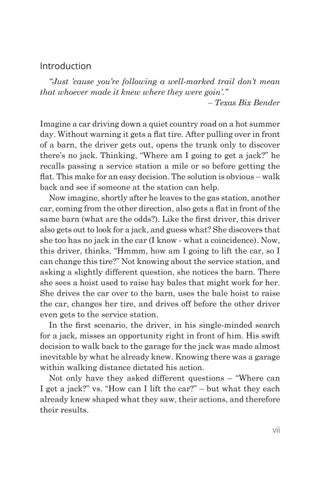Introduction “Just ’cause you’re following a well-marked trail don’t mean that whoever made it knew where they were goin’.” – Texas Bix Bender Imagine a car driving down a quiet country road on a hot summer day. Without warning it gets a flat tire. After pulling over in front of a barn, the driver gets out, opens the trunk only to discover there’s no jack. Thinking, “Where am I going to get a jack?” he recalls passing a service station a mile or so before getting the flat. This make for an easy decision. The solution is obvious – walk back and see if someone at the station can help. Now imagine, shortly after he leaves to the gas station, another car, coming from the other direction, also gets a flat in front of the same barn (what are the odds?). Like the first driver, this driver also gets out to look for a jack, and guess what? She discovers that she too has no jack in the car (I know - what a coincidence). Now, this driver, thinks, “Hmmm, how am I going to lift the car, so I can change this tire?” Not knowing about the service station, and asking a slightly different question, she notices the barn. There she sees a hoist used to raise hay bales that might work for her. She drives the car over to the barn, uses the bale hoist to raise the car, changes her tire, and drives off before the other driver even gets to the service station. In the first scenario, the driver, in his single-minded search for a jack, misses an opportunity right in front of him. His swift decision to walk back to the garage for the jack was made almost inevitable by what he already knew. Knowing there was a garage within walking distance dictated his action. Not only have they asked different questions – “Where can I get a jack?” vs. “How can I lift the car?” – but what they each already knew shaped what they saw, their actions, and therefore their results. vii
Issuu converts static files into: digital portfolios, online yearbooks, online catalogs, digital photo albums and more. Sign up and create your flipbook.




